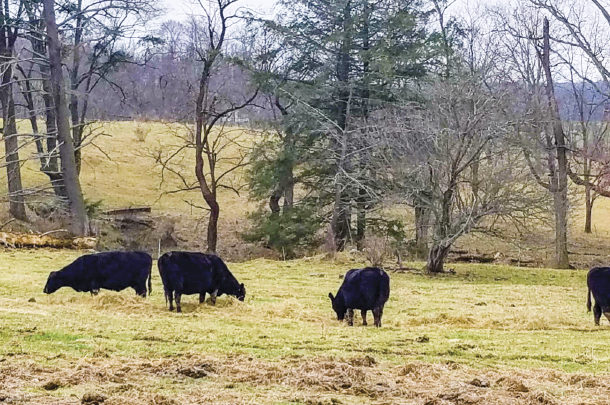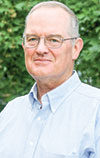Livestock often need to be fed hay during the winter and during droughts. Hay, pasture and supplemental feeds contain nutrients needed by both plants and animals.
When fed to animals, nutrients not used in maintenance, growth or milk production are excreted in manure and urine.
It is good management to recover the excreted nutrients and place them where they can be used to grow plants to produce another crop.
This needs to be managed in tune with soil fertility.
The fertilizer nutrients in hay and pasture dry matter (DM) are highly related to forage quality, measured as crude protein (CP) in the DM (Table 1).
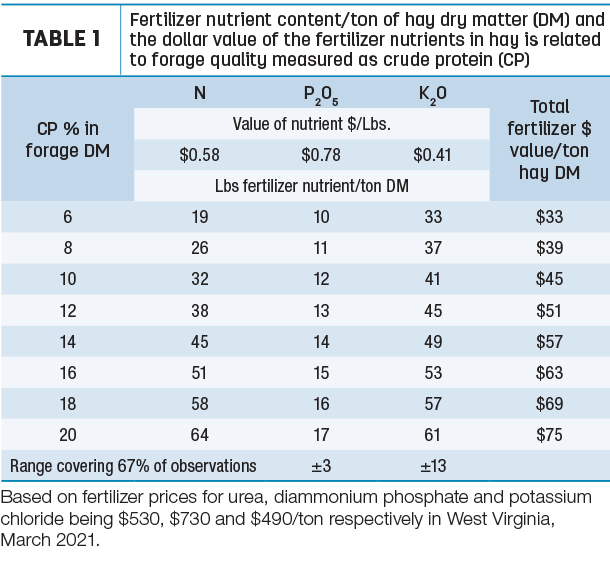
Using West Virginia 2021 spring prices for urea, diammonium phosphate and potassium chloride, the total value of the fertilizer nutrients nitrogen (N), phosphate (P2O5) and potash (K2O) in hay ranges from $33 to $75 per ton DM. A typical first-cut yield is 2 tons per acre. That means $66 to $150 per acre of fertilizer is being removed from the soil in first-cut hay. These nutrients need to be returned to the soil as fertilizer or in manure to maintain soil fertility and forage productivity over time. Nitrogen can be provided by legumes, but the P2O5 and K2O need to be purchased or recycled.
In pastures, the amount of nutrients cycled by grazing is greater than that taken off in livestock products (Table 2).
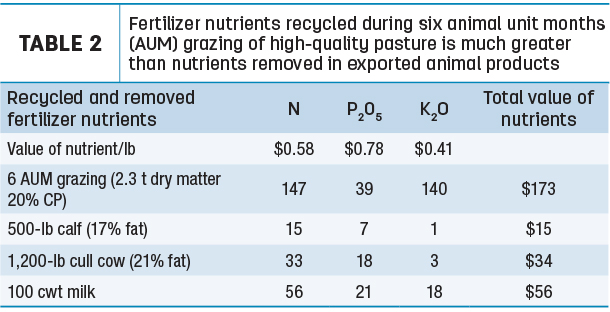
In a cow-calf operation, if every 1,200-pound cow produces 6,500-pound calves over an eight-year life, fed pasture for six months and hay for six months, the nutrients available for cycling are 94% of the N, 90% of the P2O5 and 99% of the K2O. Calf and cull cow animal product removal averages 19 pounds N, 9 pounds P2O5 and 2 pounds of K2O per year.
To put forage quality into perspective, average first-cut beef-quality hay in West Virginia is 10% CP, and second-cut grass-clover hay and continuously grazed pasture contain 16% CP, while well-managed rotationally grazed pasture is 20% CP. Managers can fine-tune these fertilizer values for their operation by forage testing.
Forage analysis reports crude protein and elemental phosphorus (P) and potassium (K). Fertilizer nutrients are calculated as:
CP percentage / 6.25 = N percentage
P percentage x 2.3 = P2O5 percentage
K percentage x 1.2 = K2O percentage
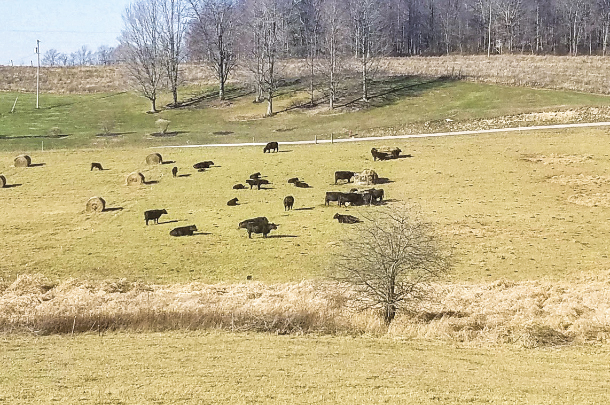 Cows eat unrolled hay on dry ground. Photo provided by Ed Rayburn.
Cows eat unrolled hay on dry ground. Photo provided by Ed Rayburn. The economic value of recycling nutrients in winter-fed hay varies. Using 10% CP hay, fed at 80% efficiency for six months, the cost is about $130 per cow wintered. For a 30-cow herd, this is $3,900. Keeping fertilizer nutrients where they can be reused makes economic sense.
Bale grazing is a low-cost option for winter feeding hay to recycle nutrients on hay land or build fertility on pastureland. There are differing opinions on bale spacing when bale grazing. When feeding on pasture at a low rate, 5,800-pound bales per acre (93 x 93 feet spacing) is equivalent to 2 tons hay per acre. On hay land when feeding on part of a hay field every four to six years, a higher bale density may be more practical (Table 3).
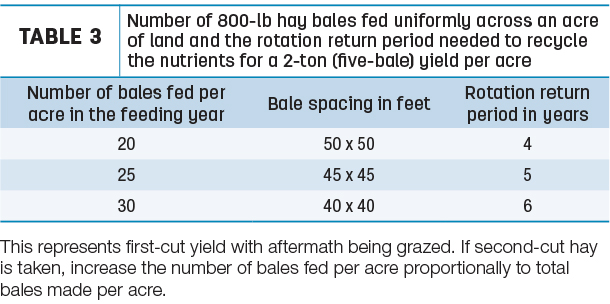
Use the following guidelines for bale grazing on meadows and pastures:
• Soil test all meadows and pastures to determine their fertility status every three to five years to know where fertilizer nutrients are most needed.
• Feed hay in hay meadows to return nutrients removed in harvest and to build soil fertility into the optimum range.
• Feed hay in pastures to build soil fertility into the optimum range.
• Feed 50 feet away from fencelines, water tanks and wind breaks; 100 feet away from streams and drainage ways; 200 feet away from household wells and springs.
• Do not feed more than one bale in the same spot in one feeding season.
• Rotate feeding areas across hay fields on a four- to six-year cycle.
• Feed bales in feeders during wet, muddy weather or unroll bales on dry or frozen ground.
• Do not winter feed on wet soils that will not take the animal traffic.
• Feed on wet ground when frozen or during summer droughts to recycle nutrients.
• If needed, broadcast seed and chain harrow after the feeding season to revegetate the area.
• If needed, cultipack or roll the feeding area to smooth the soil surface.
